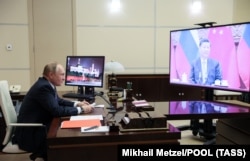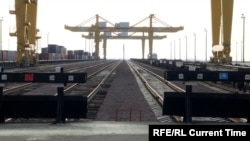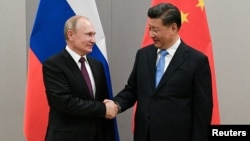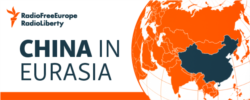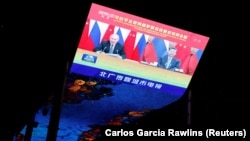
What a difference a year can make.
Already feeling triumphant from its handling of the COVID-19 pandemic at home, China marked a geopolitical win by signing a massive trade deal with the European Union in late December 2020 that sent a powerful message to U.S. President Joe Biden’s incoming administration.
But 2021 had other plans for Beijing.
The investment deal was sidelined indefinitely in May following tit-for-tat sanctions between China and the EU over Beijing's abuses of Uyghurs and other minority Muslims in its western Xinjiang Province.
Since then, Taiwan has improved its ties across Europe, with Taiwanese Foreign Minister Joseph Wu launching a landmark tour of several Central European countries in October.
Lithuania, a small Baltic country of 2.7 million people, has also been at the center of Chinese-European ties, withdrawing from a Beijing-led diplomatic format in February and then navigating a prolonged spat over its ties to Taipei that has seen China launch a fierce propaganda campaign, economic sanctions, and a diplomatic dispute that led to Vilnius leaving its embassy in Beijing on December 15.
While Europe still lacks a cohesive plan for dealing with China, the events of 2021 have emboldened officials and governments from the bloc to call for a harder line toward Beijing. The entire episode represents the wider mix of diplomatic opportunities and strategic missteps that defined Chinese policy from Central Europe to South Asia this past year.
Looking ahead to 2022, China is poised to continue its uneven rise across Eurasia.
Tensions between Russia and the West have helped fuel even warmer ties between the Kremlin and Beijing, and the chaotic U.S. withdrawal from Afghanistan and the Taliban’s return to power has opened the door for opportunities, while also bringing new risks.
Meanwhile, the coming year will see a key moment in modern Chinese history as President Xi Jinping is predicted by many to abandon term limits and seek one-man rule.
With a new year of globe-spanning developments on the horizon, here are five big trends to watch as China deepens its influence throughout Eurasia.
1. China's Security Footprint Cautiously Expands
Concerns over border security, extremist groups, and the security of Chinese personnel across Central and South Asia grew this year following the Taliban’s August takeover and a spate of attacks on Chinese nationals working in Pakistan.
Beijing has long worried about terrorism in the region, particularly from Uyghur extremist groups, and it has moved to build up security relationships with all its neighbors -- from Central Asian governments to the Taliban -- that link China’s internal security apparatus to foreign counterparts.
“So far, [Beijing] has demonstrated that it views its security interests narrowly to things that it fears can impact China directly [at home],” Raffaello Pantucci, a senior associate fellow at London's Royal United Services Institute, told RFE/RL.
Many of these partnerships continued to grow in 2021.
In October, it was announced that China would fund and build a police base in Tajikistan for Tajik personnel, while an RFE/RL investigation showed that China’s presence at a base along the Afghan-Tajik border continues to grow, with Chinese personnel even patrolling stretches of the border.
“China has shown that it prefers a light touch and would like to focus on building relationships [with local governments] to address security concerns,” said Pantucci. “The big question is whether Chinese interests being targeted more and more leads to Beijing thinking it needs to have a different kind of presence on the ground.”
In the meantime, those links look set to grow with law enforcement and security agencies across the region for the year ahead. Beijing continues to invest in training for many of its neighbors, and China has reportedly signed 59 extradition treaties with foreign countries in recent years.
2. A New Era For Beijing And Moscow?
Xi and Russian President Vladimir Putin hailed their increasingly close ties on December 15 during a 90-minute video call in which they sought to display a unified front amid Western pressure on both China and Russia.
Moscow and Beijing are not formally allied, but during the call, Putin said that “a new model of cooperation between our countries has formed on principles such as noninterference in internal affairs and respecting each other’s interests,” while Xi thanked his counterpart for his “strong support of China’s efforts to protect its key international interests.”
Their ties are getting closer as their rivalries with the United States intensify, conducting joint military exercises and even offering political support for each other on a range of issues, from Putin criticizing the AUKUS military alliance (composed of Australia, the United States, and Britain) to Xi supporting Moscow’s demand for security guarantees to limit the West’s influence across the former Soviet Union.
“They are getting closer, and while they don’t want to formalize an alliance, [they’re] increasingly willing to support each other on issues that don't affect the other,” said Pantucci.
How close this relationship will progress remains to be seen, especially as Russia anxiously watches China’s security and political influence grow across Central Asia and each country’s regional economic model -- the Moscow-led Eurasian Union and China’s Belt and Road Initiative (BRI) -- faces high tariffs and coordination problems, despite the rosy rhetoric.
But with tensions only set to grow with the West in 2022, expect Putin and Xi to lean on each other even more in the future.
“We are seeing this relationship transform in real time,” said Pantucci. “We need to update our thinking, as this dynamic continues to change and potentially becomes something more durable.”
3. Polishing The Belt And Road
In less than 10 years, the BRI has positioned China at the center of the international system, with new railroads and bridges, fiber-optic cables and 5G networks, pipelines and ports that have helped expand Beijing’s financial, technological, and political influence through hundreds of billions of dollars in investment and projects from Latin America to Southeast Asia.
But the foreign policy project has hit plenty of speed bumps lately, including debt concerns linked to Chinese projects and allegations of corruption, shoddy construction, poor labor practices, and disregard for the environment. Investment levels have also declined steadily since 2016, and the BRI has begun to shift focus to new areas, such as arts and culture, e-payment systems, and satellites.
This backlash has also opened the door for new competing initiatives from Japan, the United States, and the European Union.
“By design, it’s meant to be abstract and vague. The point was that any Chinese stakeholder could come in and do any project and that could be called part of BRI,” Niva Yau, a senior researcher at the OSCE academy in Bishkek, told RFE/RL. “We need to stop thinking of it as one thing. It’s always changing and is ultimately about China increasing its influence in all aspects globally.”
Looking to 2022, Xi’s signature project will continue to evolve, and Yau says China is already putting a greater emphasis on soft power and courting public opinion through aid, medical assistance, exporting Chinese culture, and creating local jobs rather than only winning over political elites.
“[BRI] is targeting the public more and more. Of course, this isn't always effective, but that isn’t really what matters right now,” she said. “If they continue to invest in soft power and devote resources towards it, that will eventually see some results.”
4. 'Wolf Warriors' Are Here To Stay
But while the BRI continues to search for new ways to boost China’s global influence, Beijing will have to deal with an increasingly negative global view of the country that has hurt both Chinese soft power and diplomacy over the past year.
A Pew survey in June of mostly Western, developed countries found that unfavorable views of China have reached new heights, with only a majority of respondents from Greece and Singapore showing a favorable view of Chinese policies.
“It's undeniable that China's image is in a poor state and looks unlikely to improve substantially any time soon,” Charles Dunst, a fellow at the Center for Strategic and International Studies, told RFE/RL.
Beijing’s COVID-19 diplomacy, which had some small victories early in the pandemic in countries like Serbia and Italy, has since faded.
The country’s so-called “wolf warrior” diplomats, who have adopted an aggressive style of targeting and coercing governments, companies, and individuals that criticized China, are here to stay and even threatened to cut off aid or access to vaccines and personal protective equipment (PPE) in some cases.
Many also spread disinformation about the origins of the coronavirus, and Beijing went on to place restrictions and tariffs on some of Australia’s most popular exports after Canberra called for an investigation into the origins of COVID-19.
“Countries around the world are worried most about Beijing's willingness to wield economic ties for political purposes,” he said. “It's hard to see China reversing this trend in 2022, given both [Xi’s] clear preference for foreign policy aggressiveness and popular Chinese nationalism.”
5. The Limits Of Trading With COVID-Zero China
China is one of the last countries in the world to continue with a strict "zero-COVID-19" strategy, which sometimes entails locking down entire cities if a single case is detected. Now, with the spread of the omicron variant, it looks like that policy is here to stay.
That’s bad news for many across Central Asia who rely on cross-border trade, which has seen a precipitous drop over the course of the pandemic due to rigid border controls and restrictions on the types of people and goods that have been allowed to come into China.
“China and Central Asia will have many difficulties in their trade relations not only in the upcoming year but well into the future, depending on how the pandemic develops,” Temur Umarov, an expert on China in Central Asia at the Carnegie Moscow Center, told RFE/RL.
The vast majority of Chinese trade with the region is focused on natural resources, especially oil and gas, but the pressures on freight trade brought by China’s border restrictions have become a political issue in some countries.
The Kyrgyz government has said that restarting some version of pre-pandemic trade is a priority, and officials from Bishkek have held talks with their Chinese counterparts and even proposed a new system for cargo trucks to better comply with Chinese COVID-19 regulations.
With new variants of the virus continuing to emerge, Umarov says, this remains the only option on the table for local governments.
“Of course, this will frustrate Central Asia,” he said. “But at the same time, they need China economically, and that is why they will have to go and take these additional steps and negotiate what they can for cross-border traffic.”






